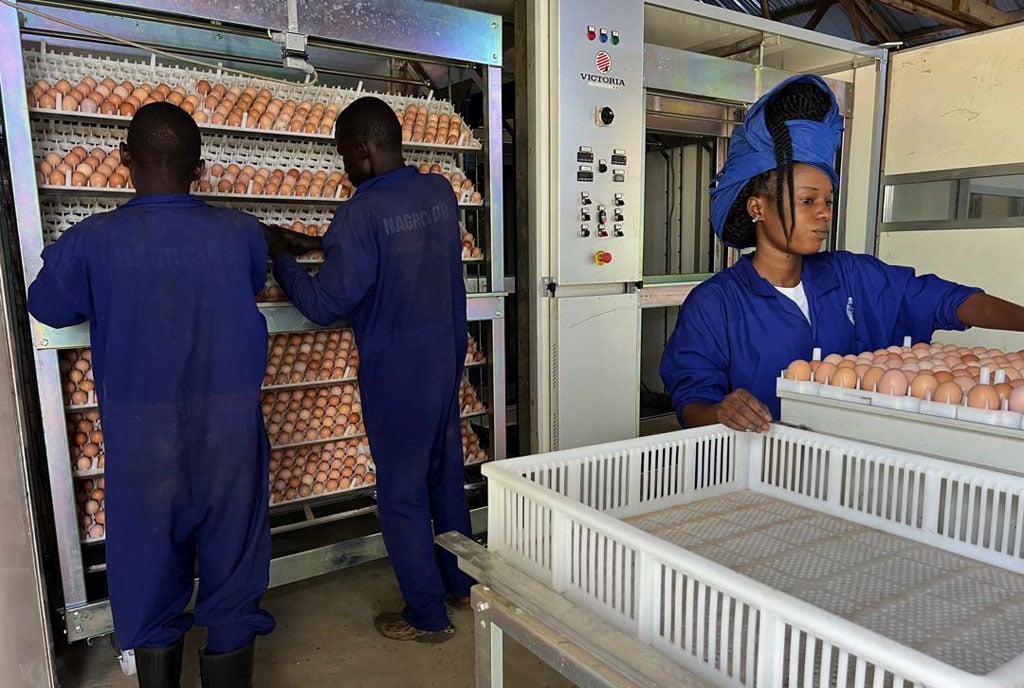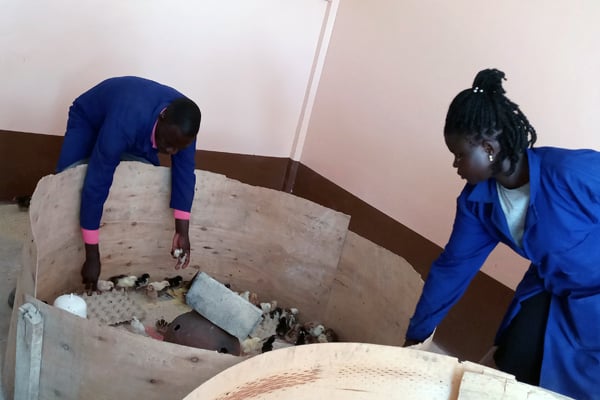Prime
Nagrc&DB seeks to breed indigenous layers, broilers

Farm workers at Nagrc&DB place eggs in the hatchery. PHOTO/COURTESY
What you need to know:
- A poultry scientist, Mr Jackson Mubiru, says that efforts are being made to ensure that these local varieties produce with much more frequency than they would ordinarily do.
The National Animal Genetic Resources Centre and Data Bank (Nagrc&DB) has commenced conserving and improving indigenous chicken species for purposes of yielding stocks in the form of indigenous layers, broilers, and dual-purpose backyard chicken.
The process which also entails bolstering the rate at which they produce is under way at the newly opened National Poultry Development Centre in Wakiso.
Dr Peter Beine, the executive director of NAGRC&DB, the government agency charged with a twofold mandate of spearheading livestock breeding and development activities in Uganda, and also playing a leading role in the commercialisation of animal breeding activities, says that the facility in Wakiso is equipped with a modern internationally recognised hatchery machines that offer a high hatchability, which is expected to greatly support production processes.
“We are going to be breeding and multiplying first generation chicks of all ecotypes of chicken for sale to farmers in different parts of the country at subsidised prices,” Dr Beine said.
The organisation’s scientists, he said, have collected indigenous chicken genetic materials from places including Amuria in Teso, Masindi and Kiryandogo in Bunyoro, Adjumani in West Nile and Kisoro in Western Uganda, which are now being conserved and improved at the national poultry development centre.
“The conservation of these valuable indigenous chicken genetic resources is necessary in the light of the rapid loss of indigenous breeds and strains through rapid commercialisation of poultry farming mostly by the private sector that have caused the influx of commercial breeds bred for specific traits such as rapid growth,” Dr Beine said.
Production targets
A poultry scientist, Mr Jackson Mubiru, says that efforts are being made to ensure that these local varieties produce with much more frequency than they would ordinarily do.
“Nagrc currently has about 50,000 laying parent stock of both rainbow and Kuroiler birds from which we expect 80 percent to lay given that natural science hardly permits them all to lay at the same time,” says Mr Mubiru.
Dr Jude Sserwano, the head of the poultry unit at NAGRC&DB says arrangements have been put in place to ensure mass production.
“With the current number of the parent stock available, we expect on average to produce about 200,000 day old chicks(DOC) per day, which will all be accessed by farmers at subsidised rates to boost their agricultural enterprises” Dr Sserwano.
This is expected to heavily reduce the country’s reliance on imported day old chicks. Poultry farmers have until now been imported most of the day old chicks from Kenya and countries as far away as India, which has been taking a toll on foreign exchange earnings.
It has also been an impediment to the acquisition of varieties of poultry breeding stocks for different farmer groups, a problem that the new centre is likely to cure.
Quality controls
According to Dr Sserwano, mechanism, have been put in place to ensure that farmers who buy from the centre have the best available on the market.
“As a breeding agency, we will be in possession of the original parent stock, which means that farmers that purchase from us will have an original F1 addressing the risk of purchasing fake products that are common on the market,” he said.
The new state of the art centre also has an automated vaccination system, which means that all chicks to be supplied to farmers will be fully vaccinated.
“Implementing this cost-effective hatchery vaccination technique will directly benefit farmers in terms of reduced operational expenses,” Dr Beine says.
Feeds
Nagric is at the same time working to ensure that farmers who buy day old chicks from it also have access to quality feeds.
“The facility in Wakiso will be fully supported by feeds mill at Kasolwe. The mill which has an installed production capacity of five metric tonnes per hour manufactures feeds of all kinds in form of a crumble, pellets or marsh,” Dr Sserwano said.
Over all, Dr Beine said, Nagric aims to help grow the local poultry industry to not only meet local demands, but also be able to take advantage of the East African market which has a population of over 300 million people.
“This presents significant opportunities due to regional demand for poultry products. Uganda’s strategic proximity to other countries in the region allows for easier trade and export potential. Additionally, increasing urbanisation and a growing middle class in the region drive demand for poultry products, creating opportunities for Ugandan producers to expand their market reach,” he said.
Key fact
Dr Peter Beine, the executive director of Nagrc&DB, the government agency charged with a twofold mandate of spearheading livestock breeding and development activities in Uganda, and also playing a leading role in the commercialisation of animal breeding activities, says that the facility in Wakiso is equipped with a modern internationally recognised hatchery machines that offer a high hatchability.




